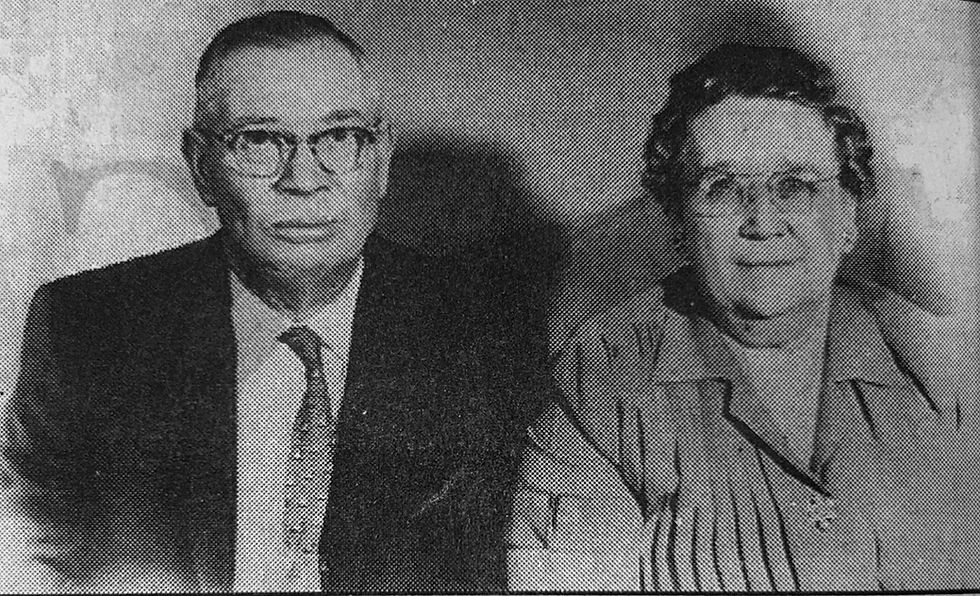Recollections: Legends of Yesterday - C.P. Cassidy and the Railroad
- gvnews7
- Jun 16, 2024
- 4 min read

I forgot to mention the life of a steam engine. I had in my information somewhere that Casey's engine #382 served 37 years before it was retired. I wondered about the saw mill engines, so I called a nephew who used to run steam sawmills. J.V. Woolley told me that he ran an engine for over 20 years, and he could not remember overhauling one. That says somebody overcame friction and they did not have the lubrication that they have today.
Railroads certainly had their impact on the nation and still move more goods each year than the average citizen would think. I remember well that Charles Jackson, vice president of Mississippi Chemical Corp (my former employer) made a statement to the fieldmen. He said, "Don't think we are not dependent on the railroad." He said we would shut down overnight if it weren't for the railroads. Nearly all our raw materials were transported by rail and barge. However, we shipped a lot of finished products by rail also. Mr. Jackson stated that if the railroads were shut down, the nation would shut down also.
Railroads had a direct effect on the little town of Graceville. The railroad created the south side of town, known as New town. Old town was located around the crossroads of White Avenue and Cotton Street, where Jim Hinson ran the first store. According to Mr. George Grace (Grace Notes), a man by the name of Drake built the first store in new town which was just north of the new library (old L&N depot site). The first brick building was built in 1904 by Frank Davis, father of Mrs. Claude Tindel. Waters and Davis ran a General Mercantile. Mr. E.D. Patterson came down from Brundidge in 1908 and was in charge of the hardware department which he purchased 1/2 interest in 1911 and by 1915 he was owner of the hardware. Mr. Patterson then moved up the street and built Patterson Hardware and had, according to Grace Notes in 1960, the oldest, continuous mercantile business in Graceville.
The Mike Hand Gin was erected about the same time that the railroad was built and old Green Cotton Warehouse on Cliff Street was one of the first building in New Town. Mr. Byrant White who was almost 100 years old told me that the old cotton warehouse had been there as long as he could remember. Davis Tindel, former owner, told that he understood it was built at the same time as the railroad. Livestock pens were built along the railroad so cattle could be shipped to Montgomery. Graceville, as many small towns began to flourish. The economic impact by the movement of goods all over the nation gave a great boost to the entire United States. The railroad workers were paid two times each month. They were generally paid good wages.
I had a brother-in-law and two uncles that worked with the railroad. We always considered them rich because of the good salary and regular pay. I had one uncle who had retired, but Mr. Flagler (east coast railroad owner) pulled him out of retirement to correct some of the mistakes that were made in building the East coast railroad between Jacksonville and Key West.
According to Grace Notes and Dr. Windsor's History of Graceville, C.P. Cassidy drove the first regular scheduled steam engine into Graceville in 1902. Before then only work trains carrying materials for building the L&N railroad were run over the new tracks. I am not sure where Mr. Cassidy came from, but I feel like he never dreamed of later becoming a permanent resident of Graceville and marrying a local girl. This girl was Essie Grace, Mr. George Grace's sister.
Mr. George used to have the gold watch the engineer had on him when he first came in on the historical run. Engineers had the best of watches. I asked Margie Mixson to give me a unique story about Mr. Cassidy (her uncle). She replied, "He was Catholic." Picture this--a Catholic fellow coming into this Methodist and Baptist strong hold. Margie said he was a good man and attended the Methodist church with her Aunt Essie who taught Sunday School for many years. Mr. George Grace said he was a good man, also. Mr. George would often help take up the offering at the Methodist Church. He said that if a $5 bill was in the offering plate, he knew that C.P. Cassidy was in the congregation. It stood out among the crumpled one-dollar bills.
J.K. Powell tells me this story. Mr. C.P. had a new kerosene floor furnace installed in his large framed house located on Cotton Street. About the same time a neighbor's house burned to the ground. It was said that the cause was probably the floor furnace. Mr. Cassidy, being a locomotive engineer knew about fires and refused to light his furnace. J.K. said Coy Clark bought the furnace from Mr. Cassidy and installed it in J.K.' house. There will be more on railroad days at the end of the L&N line coming up.
I forgot to mention that Mrs. Essie Cassidy is the person who spear-headed the planting of the old crepe myrtles and palms along the highways leading into Graceville many years ago.
Joe Bill Hodges said that he delivered groceries many times to the large two-story house that C.P. and Essie lived in on Cotton Street.
Photo Cutline: Mrs. C.P. Cassidy
To Subscribe To The Graceville News Visit Pricing Plans.





Comments